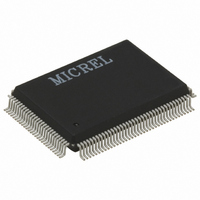KSZ8842-32MQL Micrel Inc, KSZ8842-32MQL Datasheet - Page 41

KSZ8842-32MQL
Manufacturer Part Number
KSZ8842-32MQL
Description
2-Port Ethernet Switch/Repeater + Generic (32-bit) Bus Interface( )
Manufacturer
Micrel Inc
Specifications of KSZ8842-32MQL
Controller Type
Ethernet Switch Controller
Interface
PCI
Voltage - Supply
3.1 V ~ 3.5 V
Operating Temperature
0°C ~ 70°C
Mounting Type
Surface Mount
Package / Case
128-MQFP, 128-PQFP
Number Of Primary Switch Ports
2
Internal Memory Buffer Size
32
Operating Supply Voltage (typ)
3.3V
Fiber Support
Yes
Integrated Led Drivers
Yes
Phy/transceiver Interface
MII
Power Supply Type
Analog/Digital
Package Type
PQFP
Data Rate (typ)
10/100Mbps
Vlan Support
Yes
Operating Temperature (max)
70C
Operating Temperature (min)
0C
Pin Count
128
Mounting
Surface Mount
Jtag Support
No
Operating Supply Voltage (max)
3.5V
Operating Supply Voltage (min)
3.1V
Operating Temperature Classification
Commercial
Data Rate
100Mbps
Lead Free Status / RoHS Status
Lead free / RoHS Compliant
For Use With
576-1634 - BOARD EVALUATION KSZ8842-16MQL
Current - Supply
-
Lead Free Status / RoHS Status
Compliant, Lead free / RoHS Compliant
Other names
576-1479
576-1479-5
576-1479-5
576-1479-5
576-1479-5
Available stocks
Company
Part Number
Manufacturer
Quantity
Price
Company:
Part Number:
KSZ8842-32MQL
Manufacturer:
Micrel
Quantity:
167
BIU Implementation Principles
Since the KSZ8842M is an I/O device with 16 addressable locations, address decoding is based on the values of A15-A4
and AEN. Whenever DATACSN is asserted, the address decoder is disabled and a 32-bit transfer to Data Register is
assumed (BE3N – BE0N are ignored).
If address latching is required, the address is latched on the rising edge of ADSN and is transparent when ADSN=0.
Queue Management Unit (QMU)
The Queue Management Unit (QMU) manages packet traffic between the MAC/PHY interface and the system host. It has
built-in packet memory for receive and transmit functions called TXQ (Transmit Queue) and RXQ (Receive Queue). Each
queue contains 4KB of memory for back-to-back, non-blocking frame transfer performance. It provides a group of control
registers for system control, frame status registers for current packet transmit/receive status, and interrupts to inform the
host of the real time TX/RX status.
Transmit Queue (TXQ) Frame Format
The frame format for the transmit queue is shown in the following Table 3. The first word contains the control information
for the frame to transmit. The second word is used to specify the total number of bytes of the frame. The packet data
follows. The packet data area holds the frame itself. It may or may not include the CRC checksum depending on whether
hardware CRC checksum generation is enabled.
Multiple frames can be pipelined in both the transmit queue and receive queue as long as there is enough queue memory,
thus avoiding overrun. For each transmitted frame, the transmit status information for the frame is located in the TXSR
register.
Since multiple packets can be pipelined into the TX packet memory for transmit, the transmit status reflects the status of
the packet that is currently being transferred on the MAC interface (which may or may not be the last queued packet in the
TX queue).
The transmit control word is the first 16-bit word in the TX packet memory, followed by a 16-bit byte count. It must be
word aligned. Each control word corresponds to one TX packet. Table 4 gives the transmit control word bit fields.
Micrel, Inc.
October 2007
1. Byte, word, and double-word data buses and accesses (transfers) are supported.
2. Internal byte swapping is not implemented and word swapping is supported internally. Refer to Figure 13 for the
3. Since independent sets of synchronous and asynchronous signals are provided, synchronous and asynchronous
4. The asynchronous interface uses RDN and WRN signal strobes for data latching. If necessary, ARDY is de-
5. The VLBUS-like synchronous interface uses BCLK, ADSN, and SWR and CYCLEN to control read and write
6. The EISA-like burst transfer is supported using synchronous interface signals and DATACSN when I/O signal
appropriate 8-bit, 16-bit, and 32-bit data bus connection.
cycles can be mixed or interleaved as long as they are not active simultaneously.
asserted on the leading edge of the strobe.
operations and generate SRDYN to insert the wait state, if necessary, when VLBUSN = 0. For read, the data must
be held until RDYRTNN is asserted.
VLBUSN = 1. Both the system/host/memory and KSZ8842M are capable of inserting wait states. To set the
system/host/memory to insert a wait state, assert RDYRTNN signal. To set the KSZ8842M to insert a wait state,
assert SRDYN signal.
Packet Memory
Address Offset
0
2
4 - up
Table 3: Transmit Queue Frame Format
Bit 15
2
Control Word
Byte Count
Packet Data
(maximum size is 1916)
nd
41
Byte
1
st
Bit 0
Byte
KSZ8842-16/32 MQL/MVL/MVLI/MBL
M9999-102207-1.9

















